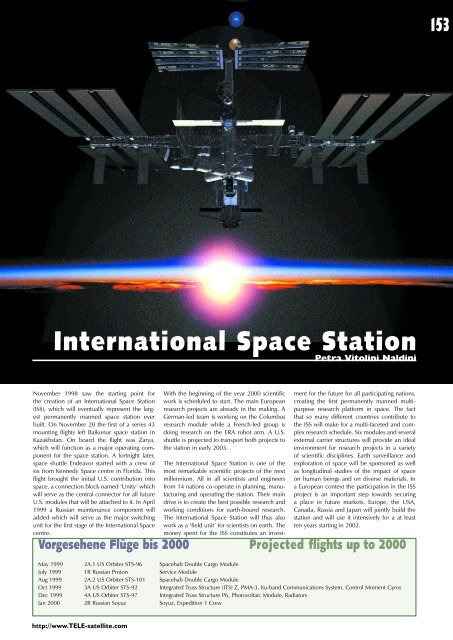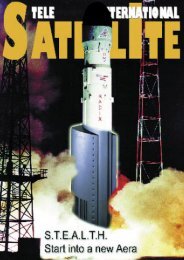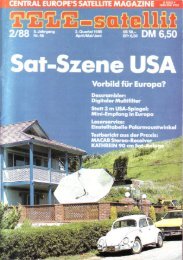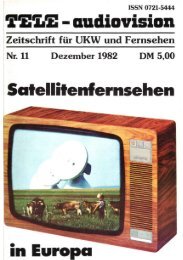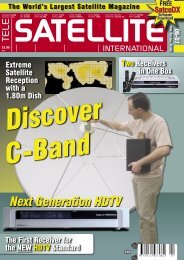Bestellen Sie diesen Satelliten- Newsletter! - TELE-satellite ...
Bestellen Sie diesen Satelliten- Newsletter! - TELE-satellite ...
Bestellen Sie diesen Satelliten- Newsletter! - TELE-satellite ...
Create successful ePaper yourself
Turn your PDF publications into a flip-book with our unique Google optimized e-Paper software.
International Space Station<br />
Petra Vitolini Naldini<br />
November 1998 saw the starting point for<br />
the creation of an International Space Station<br />
(ISS), which will eventually represent the largest<br />
permanently manned space station ever<br />
built. On November 20 the first of a series 43<br />
mounting flights left Baikonur space station in<br />
Kazakhstan. On board the flight was Zarya,<br />
which will function as a major operating component<br />
for the space station. A fortnight later,<br />
space shuttle Endeavor started with a crew of<br />
six from Kennedy Space centre in Florida. This<br />
flight brought the initial U.S. contribution into<br />
space, a connection block named ‘Unity’ which<br />
will serve as the central connector for all future<br />
U.S. modules that will be attached to it. In April<br />
1999 a Russian maintenance component will<br />
added which will serve as the major switching<br />
unit for the first stage of the International Space<br />
centre.<br />
http://www.<strong>TELE</strong>-<strong>satellite</strong>.com<br />
With the beginning of the year 2000 scientific<br />
work is scheduled to start. The main European<br />
research projects are already in the making. A<br />
German-led team is working on the Columbus<br />
research module while a French-led group is<br />
doing research on the ERA robot arm. A U.S.<br />
shuttle is projected to transport both projects to<br />
the station in early 2003.<br />
The International Space Station is one of the<br />
most remarkable scientific projects of the next<br />
millennium. All in all scientists and engineers<br />
from 14 nations co-operate in planning, manufacturing<br />
and operating the station. Their main<br />
drive is to create the best possible research and<br />
working conditions for earth-bound research.<br />
The International Space Station will thus also<br />
work as a ‘field unit’ for scientists on earth. The<br />
money spent for the ISS constitutes an invest-<br />
ment for the future for all participating nations,<br />
creating the first permanently manned multipurpose<br />
research platform in space. The fact<br />
that so many different countries contribute to<br />
the ISS will make for a multi-faceted and complex<br />
research schedule. Six modules and several<br />
external carrier structures will provide an ideal<br />
environment for research projects in a variety<br />
of scientific disciplines. Earth surveillance and<br />
exploration of space will be sponsored as well<br />
as longitudinal studies of the impact of space<br />
on human beings and on diverse materials. In<br />
a European context the participation in the ISS<br />
project is an important step towards securing<br />
a place in future markets. Europe, the USA,<br />
Canada, Russia and Japan will jointly build the<br />
station and will use it intensively for a at least<br />
ten years starting in 2002.<br />
Vorgesehene Flüge bis 2000 Projected flights up to 2000<br />
May 1999 2A.1 US Orbiter STS-96 Spacehab Double Cargo Module<br />
July 1999 1R Russian Proton Service Module<br />
Aug 1999 2A.2 US Orbiter STS-101 Spacehab Double Cargo Module<br />
Oct 1999 3A US Orbiter STS-92 Integrated Truss Structure (ITS) Z, PMA-3, Ku-band Communications System, Control Moment Gyros<br />
Dec 1999 4A US Orbiter STS-97 Integrated Truss Structure P6, Photovoltaic Module, Radiators<br />
Jan 2000 2R Russian Soyuz Soyuz, Expedition 1 Crew<br />
153


